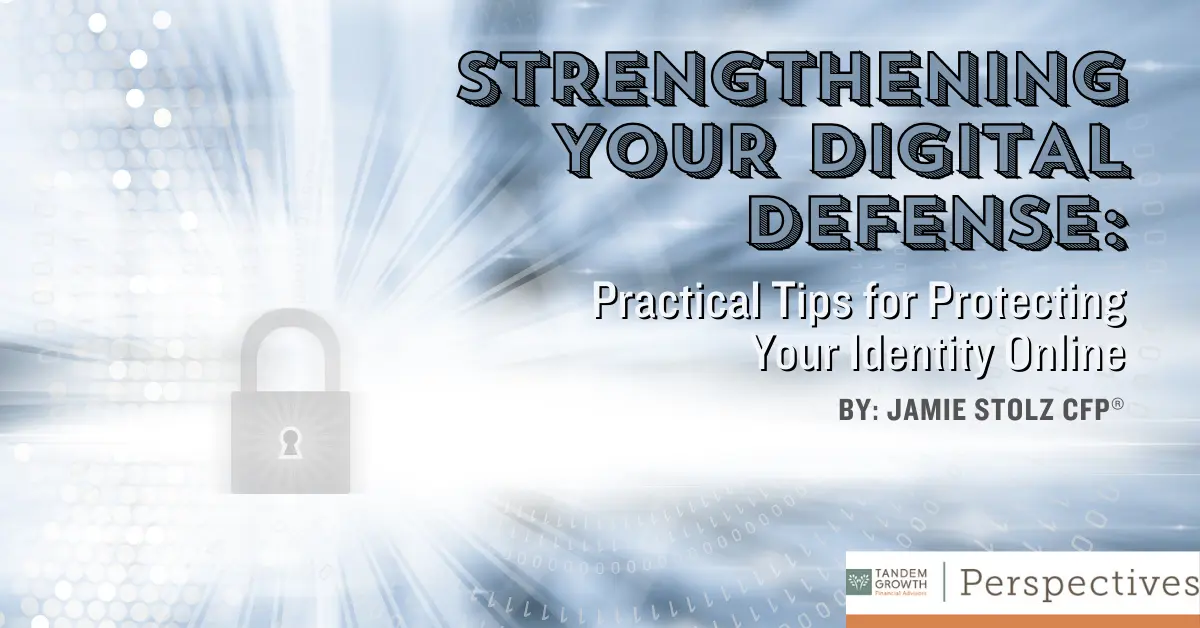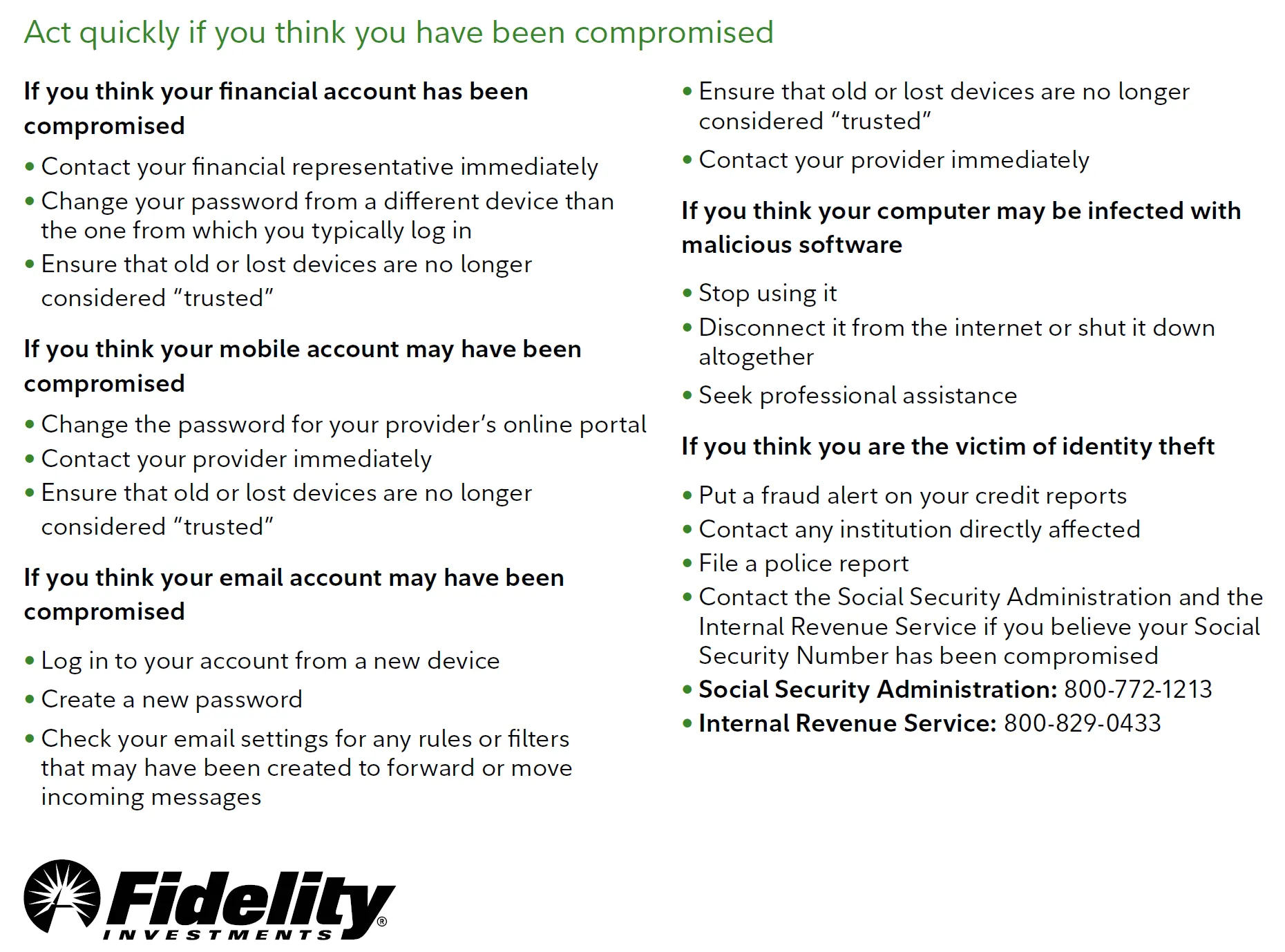
In today’s interconnected world, safeguarding your personal information is paramount. Let’s explore practical steps you can take to fortify your digital defenses and help provide some protection for yourself from identity theft and cyber fraud.
Understanding the Risks
Identity theft continues to rise, with recent statistics1 highlighting the prevalence of fraud and cybercrime:
- In 2023, the Federal Trade Commission (FTC) received a total of 5.7 million fraud and identity theft reports.
- Georgia, Maryland, Delaware, Nevada, and Florida were the five states reporting the most identity theft cases per capita.
- The median loss for victims of fraud cases is about $500, with total losses estimated at $10.2 billion.
- Every 22 seconds, identity fraud claims a new victim.
- Nearly 33% of Americans have faced some kind of identity theft attempt.
While we are not technology experts, we’ve used the sources outlined below to summarize some practical actions you can take to bolster your online security.
No Tech Strategies
- Registering for United States Postal Service Informed Delivery to monitor incoming mail.
- Investing in a shredder to securely dispose of sensitive documents.
- Opting for paperless statements wherever possible.
- Avoiding keeping sensitive information in wallets or purses.
Phishing Strategies
Phishing attacks remain a prevalent threat, but by learning some ways to recognize suspicious emails and links, you can lessen the risk of falling victim to these scams.
Many “phishing” attacks come from scammers disguised as trustworthy sources. Here are some of the most common types of phishing:2
- Email phishing is the most common, and tactics like phony hyperlinks lure email recipients to share their personal information.
- Malware phishing involves planting malware disguised as a trustworthy attachment in an email. In some cases, opening a malware attachment can harm your system.
- “Vishing” has attackers in fraudulent call centers attempting to trick people into providing sensitive information over the phone.
Here are a few ways to identify some types of phishing attempts:
- Don’t trust email display names—click to see the sender’s full email address. Scammers often create logical display names over their actual addresses.
- Check emails for typos and poor grammar.
- Hover over hyperlinks before clicking to verify their legitimacy.
- Read the salutation; don’t open the email if it looks off.
- Be wary if the email is addressed to “Valued Customer” instead of your name. It’s likely fraudulent.
- Review the signature to ensure the contact information is in the email footer.
- Beware of threats like “Your account has been suspended” via email or phone.
- Be very wary if any sense of urgency is implied or information is requested.
- Be skeptical of any text messages you receive from unknown senders.
Mitigating Modern Risks
As technology evolves, so do the tactics employed by cybercriminals. Understanding the risks associated with smartphone apps, public Wi-Fi networks, and peer-to-peer payment platforms is essential.
- Some Smartphone apps collect details about you, including age, GPS data, and browsing habits. Make certain you understand if an app accesses your camera, tracks your location, records your audio, or reads your call logs and text messages. Check out the app privacy report occasionally to see which apps are accessing your data. You should be able to turn off data tracking with an app at any time.
- Avoid using public phone chargers at airports or restaurants. They can contain malware that gives hackers access to your devices. Use a portable charger instead.
- Wi-Fi can be risky, especially in public settings. While at home, you should consider password-protecting your network and keeping router and security software up to date. You might also consider using a virtual private network (VPN) when in public. If you are on a public network, look for sites marked HTTPS. If possible, avoid making financial transactions when using an unfamiliar internet connection.
Peer-to-peer (P2P) Payment Apps like Venmo have become popular for everything from paying babysitters to splitting the check at a restaurant, but they can have some hidden risks. Top P2P scams include:3
- Impersonation scams: Criminals persuade victims to send money by pretending to be someone they’re not, and thanks to artificial intelligence, by which scammers can now clone voices and faces, these scams are becoming even more challenging to detect.
- Fake seller scams: Criminals advertise a phony product or service online, collect your money upfront, and disappear without delivering the goods.
- Advance-fee scams: A scam where someone claims you’ve won a prize and offers to send your winnings in exchange for you sending them a service fee.
To add some protection from P2P scams:
- Only use payment apps with people you know and trust, such as friends, family, or local businesses.
- Consider using a credit card if you’re transacting with someone new or unseen. Credit card providers may offer some level of fraud protection as part of their value proposition.
Building a Stronger Defense
Implementing strong passwords and multi-factor authentication is crucial for protecting online accounts4:
- Using password managers to generate and store secure passwords.5
- Enabling multi-factor authentication wherever possible.6
- Monitoring credit reports regularly and freezing credit when necessary. (Three major credit reporting agencies: Experian, Equifax, and TransUnion.)
Empowering Ourselves with Knowledge
Staying informed and remaining vigilant can go a long way in protecting our digital identities:
- Keeping abreast of cybersecurity best practices and emerging threats.
- Taking proactive steps to safeguard personal information.
- If you your identity may have been compromised, you can call the AARP Fraud Watch Network Helpline at 1-877-908-3360 for guidance and support.
Conclusion
Remember, stay informed and stay cautious. Check out this document from Fidelity for 8 tips to make yourself a difficult target for cybercriminals.

Sources:
1. IdentityTheft.org, January 2024
https://identitytheft.org/statistics/#:~:text=The%20FTC%20received%205.7%20million%20reports%20of%20identity,fraud%2C%20up%20from%204.7%20million%20the%20previous%20year.
2. Microsoft.com, February 2024
https://www.microsoft.com/en-us/security/business/security-101/what-is-phishing
3. AARP.org, January 2024
4. Microsoft.com, February 2024
https://support.microsoft.com/en-us/windows/create-and-use-strong-passwords-c5cebb49-8c53-4f5e-2bc4-fe357ca048eb
6. Zippia.com, February 2023
https://www.zippia.com/advice/mfa-statistics/
Please note that this blog is provided for informational and educational purposes only and should not be considered a substitute for professional financial advice. TandemGrowth Financial Advisors, LLC (“TandemGrowth”) is a registered investment adviser. While the information presented is believed to be factual and up to date, TandemGrowth does not guarantee its accuracy and it should not be regarded as a complete analysis of the subjects discussed.
*While the tips provided may enhance cybersecurity measures, they are not exhaustive, and there is no guarantee that following them will prevent identity theft or cyber fraud.






